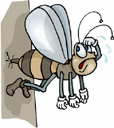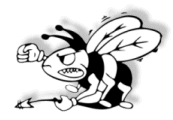|
|
 Australia has more than 1,500 species of
native bees. Many of these don't sting, some produce delicious honey, and
they come in fascinating patterns and colours. They play a vital role in
pollinating Australian wildflowers, so nurture them. Australia has more than 1,500 species of
native bees. Many of these don't sting, some produce delicious honey, and
they come in fascinating patterns and colours. They play a vital role in
pollinating Australian wildflowers, so nurture them.
Unfortunately bees and dogs just don't
get along. Puppies are fascinated by them, and dogs generally like to snap
at them while they are flying and are frequently stung in the mouth or on
the tongue.
No one likes to get stung by a bee or wasp. Such stings not only hurt, causing swelling and sharp pain, but for some individuals a sting can also cause a deadly allergic reaction to the venom. These insects will not only sting humans, but also animals which can have the same type of reaction as humans.
Dogs playing in a yard, rolling on the soft, green grass, or putting their noses into a fragrant bush can easily be stung by a bee. Dogs accidentally disturbing a hidden hive or a gathering swarm can be stung by many bees. Dogs trailing behind their owners who disturb a hive or swarm are in as much a danger from multiple stings as humans.
What to do if a dog is stung by a bee or wasp:
Usually a single sting does not present a serious problem. The exception can be the sting on the nose, mouth or around the head. If the swelling is minor, just watch the animal to be sure your pet is not having breathing or swallowing difficulties. If the swelling gets huge within five or ten minutes, see a vet immediately. It is always better to be safe than sorry.
The bee's stinger is barbed. When it stings, it pulls out of the bee's abdomen, taking the entire venom sac with it. Constriction of the muscles around the sac will continue pumping venom into the victim for several minutes after the sting. The venom of the bee contains a number of toxic proteins, which attack various body systems. Reactions range from local swelling and pain around the stung area to anaphylactic shock with total system collapse and death. These reactions may develop within minutes of the sting, and probably will occur if the reaction is allergic in nature. Even if the dog escapes the allergic threat of the toxins, it still faces the toxic threat of the venom. There may be damage to the liver, kidneys, nervous system or blood cells. These effects may be seen immediately or they may not be apparent for several days. Complete destruction of the dog's red blood cells may occur despite all efforts at treatment.
The typical bee sting case that veterinarians see in their practices involves the accidental disturbance of a hive or swarm by either the dog or its owner. This usually involves stings to both parties. If this happens to you, your best
defence is distance. Call your dog to you and run! Put as much space as possible between yourself and the bees. The bees may be quite aggressive and pursue a victim over some distance. By all means, attempt to help your dog to escape by calling to it or, if necessary, carrying it away with you. Just keep in mind that a swarm of angry insects can be life threatening to you as well as your dog. Once the attack has subsided, seek immediate medical attention for the dog, and for yourself if you were also stung.
Treatment of massive bee stings is directed at preventing shock, maintaining fluid volume, and protecting the various organ systems at risk. This can be started in the field by promptly administering antihistamines, which should be in every dog owner's first aid kit. The medication can be given orally or by injection - your veterinarian can advise you on what to do.
After rapid administration of antihistamines in the field, you should quickly take your dog to the closest veterinarian. In cases of massive stings, the dog's best chance of survival is
hospitalisation with aggressive treatment and close monitoring. At my practice we treat all bee sting cases with intravenous
catheterisation, the administration of fluids to prevent shock and circulatory collapse, the giving of corticosteroids as required and the close monitoring of vital signs. Serial blood work may be required over a two-day period to detect any damage to the dog's organs. Early detection of damage allows for prompt treatment to minimize damage wherever possible.
Ref: A.K.C. "Those Stinging Bees"

BEES STING PETS TOO!!!
 Summertime is wonderful for outdoor activities for your pet, but can result in exposure to bees, wasps, hornets, ants, and other biting insects. Summertime is wonderful for outdoor activities for your pet, but can result in exposure to bees, wasps, hornets, ants, and other biting insects.
The significance of a sting depends on the type of stinging insect, the pet's reactivity to the venom, and the location of the sting. The worst cases I have seen resulted from internal stings to the back of the mouth and throat area.
Typical signs include pain, redness, swelling, and sometimes more severe allergic-type reactions develop.
Bees have a barbed stinger. The bee dies as a result of stinging. When the stinger enters the skin, it sticks there and should be removed by gently scraping it out with a credit card or other blunt object. Avoid grabbing it with forceps since you will squeeze additional venom out of the stinger into the tissues. There is significant pain in the first hour or so, and the pet will often yelp at the time of the sting, and rub the affected part with their paws, or rub the head on the grass etc. in order to relieve the discomfort.
An ice pack applied to the affected area may provide some relief, and the dog should be monitored closely for a few hours after the event. Signs of weakness, breathing difficulty, anxious appearance, and any unusual swelling that extends significantly away from the sting site need to be followed up promptly with professional veterinary attention. Pay particular note to swelling of the head and neck area.
If the dog is swarmed by a number of bees, immediate veterinary attention should be sought. Swelling around the face and throat are particularly of concern, and professional treatment should be very prompt in these cases.
Hornet and wasp stings are more painful than bee stings, but the stinger does not become imbedded. The same guidelines for first aid and when to call the veterinarian apply as for bee stings.
If the sting is single, and a mild local reaction is present, there is no need to administer home medications. A mild self-limiting reaction is not a cause for concern.
Severe reactions, as described above require therapy at a veterinary facility since fast-acting injectable forms of medications are indicated (antihistamine, steroid, adrenaline etc.). Oral preparations of medications do not absorb quickly enough through the stomach to provide the prompt activity that is required in progressive sting reactions. Oral medications may be prescribed as a follow up therapy when the reaction is not resolving quickly, but for management of acute, severe reactions, the oral forms are not an adequate primary therapy. The progressive reactions also benefit from professional care because if the throat swells, respiratory support may be needed, and in these cases, or those of multiple sting injury, intravenous fluids and other intensive support may be required.
|
|
|
| TIPS |
|
-
Bee stings are acid. Remove the sting and bathe the area in bicarbonate of soda.
-
 Wasp stings are alkali, and the sting is not left in the skin. Bathe the area in vinegar as the sting is alkaline. Wasp stings are alkali, and the sting is not left in the skin. Bathe the area in vinegar as the sting is alkaline.
-
One way to treat bee stings is to give the dog Benadryl (diphenhydramine) by mouth. Typical dosages: for cats and dogs under 30 pounds, give 10 mg...dogs 30 to 50 pounds, give 25 mg...dogs over 50 pounds, give 50 mg.
-
Place some meat tenderiser into a bowl with a small amount of water and mix it into a paste. Apply this to neutralize the venom which will help relieve pain and swelling. Keep it on for at least 30 minutes.
|
| EUROPEAN WASP |
|
The European Wasp can sting several times and its sting causes severe pain and swelling. If your pet is bitten in the mouth it can cause breathing difficulties. It is attracted to meat and decaying food. If you have a problem with European wasps in your area it may be necessary to feed your pets inside the house and not to give your pet big bones until the nest can be removed.
Treatment is to apply cold compresses or ice to the bites. See your veterinarian if your pet is distressed, the face swells or if there are breathing difficulties.
|

|
| TIP: Wasps and
Yellow Jackets |
|
Bee venom is a water-clear liquid with a sharp, bitter taste and a distinct acid reaction. The specific gravity is 1.1313. The venom is easily soluble in water and acid, but almost insoluble in alcohol.
The three toxic effects of bee venom are neurotoxic (paralysis of the nervous system), hemorrhagic (increase in the permeability of the blood capillaries), and hemolytic (destruction of red blood cells).
Yellow jacket wasps sting readily and often are confused with honey bees. The wasps build nests in the ground and will sting when people walk or stand near the entrance, which may be difficult to locate. Stings attributed to honey bees are often caused by yellow jackets.
Homemade Wasp/Yellowjacket trap
Cut the top off a 2 litre plastic pop bottle. Make the cut just at the top
of the straight sides.
Invert the cut off top into the bottom portion and staple in place.
Pour a sweet smelling liquid into the funnel top you have made. About 2
inches of liquid in the bottom of the trap is enough. Carbonated pop (cream
soda) seems to work well but try something different in each one to
determine what your wasps prefer.
Place your traps in a wide circle 30 to 50 feet away from the area you want
to be "wasp free". Try to place some of them in the flight path. If you smack a few with a fly swatter, put them in the top of the trap. The
dead ones give off an alarm scent that will attract others. |
|
|
|
Bee Stings or Insect Bites: |
|
 Carefully scrape the stinger out with your fingernail or a credit card. Pulling on the stinger will only inject more venom. The number one gardeners friend for insect bites is pure Neem oil! Just rub a small amount of Neem on the area as often as needed: it draws out the venom, pain and swelling. Some of us react very badly to wasp and bee bites with extreme swelling and pain that lasts for days.
After applying it all symptoms are usually gone within hours! Carefully scrape the stinger out with your fingernail or a credit card. Pulling on the stinger will only inject more venom. The number one gardeners friend for insect bites is pure Neem oil! Just rub a small amount of Neem on the area as often as needed: it draws out the venom, pain and swelling. Some of us react very badly to wasp and bee bites with extreme swelling and pain that lasts for days.
After applying it all symptoms are usually gone within hours!
Wasp venom is on the alkaline side. To counteract the venom
Ant bites and bee stings are more acidic in nature. For these you want to neutralize the effect of the venom with:
-
a paste of baking soda (bicarbonate of soda) and very cold water.
-
Apply straight lemon juice.
-
A clay or mud paste can also be used to draw out the venom and is usually on hand!
-
Use a wet tea bag as a poultice: the tannic acid in tea helps with swelling. Black tea is the most
effective.
-
Meat tenderisers contain enzymes when applied as a paste also draw out the venom and swelling.
-
Put a slice of cucumber over the area, this is especially effective for ant bites!
-
A poultice using winter or summer
savoury leaves helps with bites and stings.
-
To reduce swelling put on a drop of lavender or eucalyptus oil.
|
 |
| LINKS |
|
|
|
|

E-mail
Us to report a broken link!
|
|